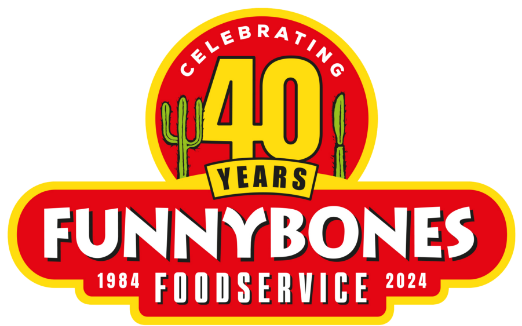The Lowdown on New Product Development
New. New. New.
For our Funnybones insight this month, we’re sitting down for a cuppa with Development Chef, Tom Styman-Heighton to find out just how he generates new ideas for product development and what it takes to make it to launch.
“Of the hundreds of products that land on my desk, only around 10% or maybe 20% will make it to launch. We have a comprehensive NPD process that involves the whole team at Funnybones, to ensure that a product is just right for our customers.”
Well, that sounds like a whole lotta work for Tom and the team. It’s a finely tuned process and it takes into account 3 key ideation areas:
Blue sky thinking
It’s good to do this, to take a good look at what’s out there, and by ‘out there’, we’re talking, global trends, what their sister companies might be launching, what’s trending on social media, what’s new in supermarkets, what street food vendors and food markets are doing and what customers are serving up. One of the team might have an idea, or inspiration could strike as they wander around a trade show. When ideas have been generated, Tom works up formulations and recipes and starts to plan how and if the product could be scaled up for mass distribution and whether it’s going to tick the boxes for the business in terms of packaging, storage, and shelf life, etc., etc., but more on that later.
Product concepts from suppliers
The process becomes a little quicker if ideas come from one of Funnybones’ suppliers. Suppliers offer a wealth of knowledge about their sector and trends in the marketplace in general, and the products that land on the kitchen table from this workstream will have already passed a check for shelf life, cooking options, storage conditions, etc. as Tom has a list of prerequisites that suppliers need to conform to before a product gets to his kitchen.
Customer requests
The final way that NPD is generated is when it comes directly from a customer. They will give Tom a brief that outlines the product, what it is, how they want to use it, how they will cook it, what price point they want etc. Tom will add in requirements from a Funnybones point of view and then create a product specification.
“This is a really collaborative process and helps build relationships with our customers. We have several meetings to discuss the brief and involve them in the whole process. It’s a great service that we can offer, and it makes sourcing new products a lot easier for our customers.”
With an agreed specification in hand, Tom contacts existing and new suppliers to find samples and get them sent to him for a taste test, (there’s a lot of tasting that goes on in this hunt for new products!). Once happy with a few options, the team will go back to the customer for yet another taste test and they work together to find the product that’s just right for the customer and for Funnybones.
Tasting and Scalability
There are regularly meetings in the development kitchen that no one wants to miss! Tom will hold an NPD session, and everyone gets to taste the potential new products and discuss the ideas around them. The products that taste good and look promising for rollout will be progressed and that means the sales team will be tasked to look at where the product could be sold, if customers would like it and generally how big could it be. For all NPD, the team needs to generate the ‘SOTP’ (size of the prize) so Tom can ascertain which products to progress to the next stage. The winning products move into the launch process for business case analysis, testing, production, and then (hopefully) launch.
Phew, Tom, that’s a lotta taste testing and explains why Funnybones’ products always taste AMAZING!
